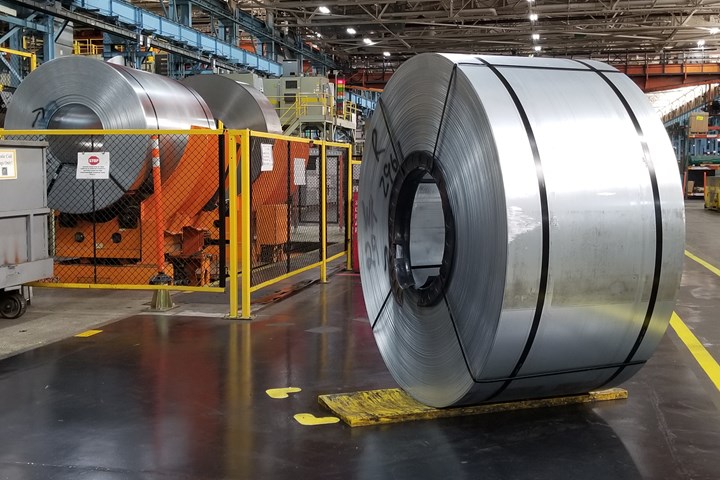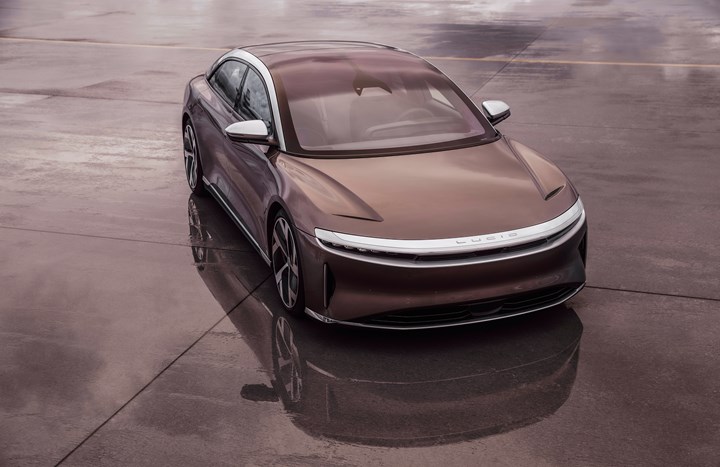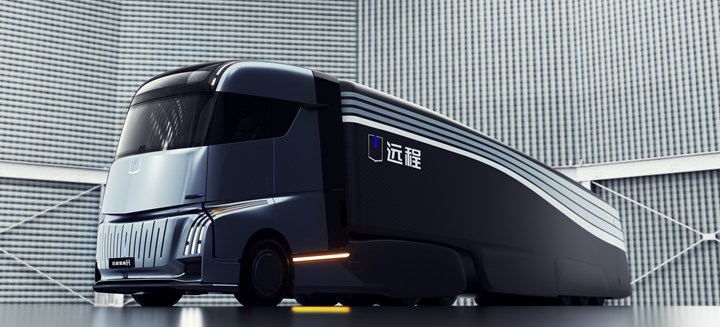On Green Car Awards, the Golf GTI, and Automated Driving
On stamping, green cars, a semi with a bathroom, a vehicle covered with solar panels, VW’s hot hatches, and a Level 3 system coming soon
This week On Automotive
- Parma Pressworking
- How Green Is My Parking Lot?
- There’s No Place Like. . .the Semi
- Sun Powered (Sort Of)
- 2022 Volkswagen GTI: A Deep(ish) Dive
- Conti Advancing Automated Driving
///
Parma Pressworking

There are over 800 tons of steel processed every day at the Parma Metal Center. (Image: GM)
One of the things that tends to be overlooked about vehicles—especially electric vehicles, although they are in no way unique in this situation—is that they have to be manufactured.
It is not just all about things like lithium batteries and autonomous driving.
There is more than a small amount of stamping and welding and so on involved in getting a vehicle on the road.
So it is worth noting that last week General Motors announced that it is investing more than $46-million in a facility in Parma, Ohio:
The Parma Metal Center.
This is a factory where:
- Over 800 tons of steel are processed each day
- There are over 750 dies
- There is a capacity of up to 100-million parts per year
The Parma facility is equipped with transfer presses (small, medium and large), high-speed progressive presses, and GM North America’s largest stand-alone, multi-cell, resistance and laser welding assembly systems.
GM is spending the money:
- On an aluminum scrap system to increase manufacturing flexibility in stamping
- Press crown replacements and control upgrades to extend the useful lives of the equipment
- On metal assembly for future product program
The investment is proceeding right now.
*Fun fact
Parma Metal Center has been in operation since 1948.
///
How Green Is My Parking Lot?

The Lucid Air: “2022 Luxury Green Car of the Year.” (Image: Lucid)
Green Car Journal has been presenting its “Green Car Awards” since 2005.
Something happened this year that has never happened before in the award’s 17-year history:
All of the vehicles named are electric vehicles.
They are:
- 2022 Green Car of the Year – Audi Q4 e-tron
- 2022 Luxury Green Car of the Year – Lucid Air
- 2022 Urban Green Car of the Year – Chevrolet Bolt EUV
- 2022 Commercial Green Car of the Year – BrightDrop EV600
- 2022 Green SUV of the Year – Hyundai IONIQ 5
- 2022 Performance Green Car of the Year – Tesla Model S Plaid
Earlier awards went to such things as hybrids and even diesels.
Now there is a sufficient number of EVs to fill out the categories.
This may be the proverbial tipping point.
At least for the “Green Car Awards”
///
There’s No Place Like. . .the Semi

Not just a transport vehicle: a home away from home. (Image: Farizon Auto)
It’s called the “Homtruck.”
While you might think that this name has more meaning in another language—say, Chinese, as it was developed by Farizon Auto, the commercial vehicle brand of Geely Holding Group—that’s not the case.
Rather, the objective of the engineers was to develop a semi “that feels like home.”
The vehicle has a bathroom including a toilet and shower. A single bed. A refrigerator. A tea maker. And a washing machine.
Soft-touch fabrics and sustainable plastics are used on the interior “to create a healthy eco-friendly environment.”
After all, long-haul truckers spend a whole lot of time in their cabs.
Technically, the Homtruck will offer L4 autonomous driving capability (hands-off within a geofenced area). And there will also be the ability for a series of Homtrucks to operate in a convoy, with truck-to-truck distance and speeds being automatically maintained.
In terms of powertrain, it will offer options, from hybrid to full battery electric.
Deliveries are planned for early 2024.
///
Sun Powered (Sort Of)

The exterior of the Sion (shown here where the vehicle will be eventually built, in the former SAAB plant in Sweden) is covered with solar panels. (Image: Sono Motors)
Sono Group announced an IPO earlier this week.
Who?
The Munich-based parent company of Sono Motors GmbH.
Huh?
The company that plans to put the Sion into production at the former SAAB plant in Trollhättan, Sweden, during the first half of 2023.
The what?
The Sion. Which Sono describes as “the world’s first solar electric vehicle for the masses.”
Solar powered?
Sort of.
It has 248 monocrystalline silicon cells on the roof, hood, fenders and sides that can generate up to 1.2 kW. The company calculates that “under ideal conditions” there is a range enhancement of 112 km (69.5 miles) per week.
The Sono is otherwise a front-drive battery electric vehicle.
By Numbers
It has a 54-kWh liquid-cooled lithium iron phosphate battery that powers a 120-kW three-phase synchronous motor.
The estimated range—battery and solar—is “up to” 305 km (189.5 miles) under the WLTP standard.
With DC fast charging it can achieve 80% charge—or 240 km (149 miles) range—in 35 minutes. (24 more minutes for a full charge.)
The estimated top speed is 140 km/h (87 mph).
Like seemingly all vehicle manufacturers of things without internal combustion engines, Sono is taking reservations for the Sion.
According to the company it has more than 16,000.
These seem to be serious because to preorder a vehicle you have to put down at least €500 and there are two two-week cancellation periods. (Make reservation and you have two weeks to withdraw it. Continue and you’ll get later get a purchase contract and have two weeks to sign or ask for a refund.)
Still, there is more than a minute between now and 2023.
///
2022 Volkswagen GTI: A Deep(ish) Dive

The Golf R (left) and GTI (right): for those who like to drive and not in an absent-minded manner. (Image: VW)
What is it?
The 2022 Mk8 Golf GTI is the quintessential “hot hatch.” The heat comes from a 2.0-liter turbocharged engine (VW code name: EA888) that produces 241 hp and 273 lb-ft of torque mated to either a six-speed manual or a seven speed DSG automatic transmission. The hatch comes from, well, it is a hatch.
Who is it for?
Enthusiasts. Who like to drive with vigor.
Why?
The reason it is for enthusiasts is because over in places like Wolfsburg, where the GTI is built, there are non-GTI versions of the Golf being built. Turns out, according to Megan Closset, product manager for the Golf family*, the enthusiasm in the U.S. has waned for things like five-door vehicles (e.g, the “regular” Golf), with interest being diverted to things like small SUVs (e.g., VW Taos). But GTI sales have stayed comparatively strong, so it is being kept in the showroom. So the grocery-getter Golf is gone in the U.S. The go-getter Golf remains.
Tech x Two. (1) There is technology for the enthusiast driver. Like a vehicle dynamics system that controls the XDS electronic differential lock; the VAQ electronically controlled, torque-sensing limited-slip differential rather than the more conventional mechanical type; and the DCC adaptive damping system, which can adjust wheel damping at 200 times per second. All of which contribute to the ability to the vehicle to handle remarkably well, particularly in cornering at speed. Of course, not everyone who is going to be driving at GTI will be continuously carving curves. There is a four-position driver mode setting function that provides choices including Comfort, Normal, Sport and Custom. This means that the suspension setup, throttle mapping and shift logic can be selected for the daily drive, including things like a trip to Costco (i.e., there is 19.9-cubic feet of luggage space behind the second row and if the second row is folded down, there is a 34.5-cubic foot cargo area inside the GTI).
(2) Then there is the entirely new electronic architecture that helps the execution of the foregoing, as well as goes to the other tech. Like the MIB3 touchscreen information system that has a capacitive interface, which means that it is more like the surface of a smartphone. Swiping works, not just pressing. The gauge cluster, known as the “Volkswagen Digital Cockpit Pro,” features a fully configurable 10.25-inch display with three views and 21 viewing options that have been designed specifically for the GTI by UX designers (e.g., car status, navigation, driving data, phone information, driver assistance features, and more). There is also a suite of safety and driver assistance tech under the moniker “IQ.DRIVE.” This brings in such thing as Travel Assist (a combo of adaptive cruise and lane-centering), Front Assist (forward collision warning and autonomous emergency braking with pedestrian monitoring), Active Side Assist (blind spot monitoring), and more.
Driven. As Megan Closset notes, there is an increasing number of people who are turning to things like the Taos. Through the third quarter of 2021 VW has sold 5,402 GTIs and 18,043 Taos models—and the Taos wasn’t launched until late May 2021. What’s more, that is an entirely new nameplate—so not something familiar—and the Golf GTI (which was then the “Golf Rabbit GTI”) goes back to model year 1983. So there is no question of the draw of the crossover.
However. . .anyone who has the need to drive from A to B and B to A on a regular basis (e.g., home to work, rinse and repeat) might find the ride to be far less monotonous by driving the GTI because the car is absolutely set up to be driven. Which is something that cannot be said with the same level of confidence for things like the Taos.
Arguably, some people have made the shift to crossovers because the cars they drove were fairly uninspired, so they might as well get some extra cargo capacity.
The GTI is something that may not entirely take people out of crossovers (unless, of course, the person in question is an enthusiastic driver, who might simply move from a Mk7 to a Mk8), but certainly it is an argument for it being the second car in the garage.
*Family? Well, admittedly small. There is also a 2022 Golf R, which has its roots in the 2004 Golf R32. This is the hella hot hatch version of the Golf, with a 2.0-liter turbo that produces 315 hp and 295 lb-ft of torque when equipped with the seven-speed DSG automatic (the six-speed manual offers 280 lb-ft). While the GTI is a front-drive vehicle, the Golf R, which has rallying in its setup, is all-wheel.
Funny thing: it has the same cargo dimensions as the GTI. So while you can drive the Golf R to the supermarket, if that supermarket is along a road with lots of curves, the problem would be the stupid grin on your face when you parked the car and went into the store.
///
Conti Advancing Automated Driving

Conti system plans which maneuver to make, even at high speeds. (Image: Continental)
Continental says that it has developed “intelligent software” that, working with the sensor systems it has developed, will bring SAE Level 3 capabilities to vehicles that aren’t necessarily in the premium category.
The software in question is called “Driving Planner.”
According to Conti, based on sensor data, its advantage is that it is able to calculate traffic situations several seconds in advance and, importantly for those who are in the vehicle, it calculates longitudinal (i.e., forward) and lateral (to the side) movements in coordination.
Presumably this means a smoother move.
Now, adaptive cruise (longitudinal) and lane change assistant (lateral) are planned individually. So unless sequenced, one can imagine a herky-jerky motion.
Two things Driving Planner can do:
- Merge from an entrance ramp onto a freeway. It accelerates, moves to the adjacent lane and adjusts speed coordinated with traffic flow.
- Make appropriate safety moves. The vehicle is traveling in the middle lane of three. Vehicles in the left lane are moving at high speed. A traffic jam forms in the right lane. A vehicle swerves from the right lane into the middle lane. The Driving Planner vehicle in the middle lane determines whether it should:
- Brake in its lane
- Accelerate and merge to the left
- Brake and then merge to the left
The system can operate at speeds up to 130 km/h (81 mph).
Conti anticipates putting it into production in 2024.
RELATED CONTENT
-
on lots of electric trucks. . .Grand Highlander. . .atomically analyzing additive. . .geometric designs. . .Dodge Hornet. . .
EVs slowdown. . .Ram’s latest in electricity. . .the Grand Highlander is. . .additive at the atomic level. . .advanced—and retro—designs. . .the Dodge Hornet. . .Rimac in reverse. . .
-
When Automated Production Turning is the Low-Cost Option
For the right parts, or families of parts, an automated CNC turning cell is simply the least expensive way to produce high-quality parts. Here’s why.
-
On Fuel Cells, Battery Enclosures, and Lucid Air
A skateboard for fuel cells, building a better battery enclosure, what ADAS does, a big engine for boats, the curious case of lean production, what drivers think, and why Lucid is remarkable


.jpg;width=70;height=70;mode=crop)






